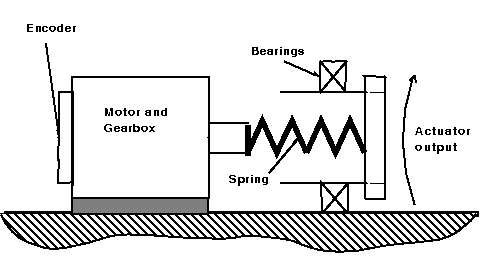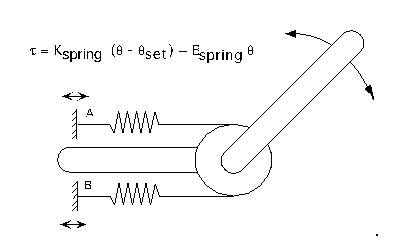The Actuators |
||
| The Actuators: MIT Artificial Intelligence Laboratory 545 Technology Square, #920 Cambridge, MA 02139 |
Details of the ActuatorsEach actuator of the arm consists of a DC electric motor with a series spring (so called Series Elastic Actuator). The spring allows low-noise force control from the geared electric motor. Essentially, electric motors operate well at high speeds and low torques,
but the majority of applications (including this one) require low speeds and high torques.
This is usually accomplished by using a transmission, the most common type being a
planetary gearbox. These types of gearboxes introduce friction, noise and backlash to the
motor output, making it hard to achieve low-noise force control. To overcome this problem
you can use a low friction, zero-backlash transmission such as a cable drive, (which tends
to be bulky and mechanically complex), or use direct-drive motors (which tend to be very
heavy). The approach used here is to insert a spring between the motor drive and the load
as shown in the figure below. The spring is linear, so the output force is proportional to its twist. If the twist is measured, then a control law can force the actuator to maintain that twist, and so give a constant force output.
You can see a short MPEG video (403Kb) of Cog's arm hammering a nail into a 2x4 piece of wood. Similar actuator technology is used in a walking robot, Spring Turkey in the MIT leglab. Spring-like BehaviorHuman muscles have a spring-like property, which can be approximately
modelled as in the figure below.
The joint has a springy behavior given by the two springs in the picture. The equilibrium point can be changed by moving A and B in opposite directions. For Cog's arms, each joint is programmed to behave in this manner, as a virtual spring with variable stiffness, damping and equilibrium point. This gives the overall arm some desirable properties.
|
|
Representatives of the press who are interested in acquiring further information about the Cog project should contact Elizabeth Thomson, thomson@mit.edu, from the MIT News Office, http://web.mit.edu/newsoffice/www/ . |
||

